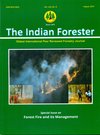Life after Fire for Understory Plant Community in Subtropical Chir Pine Forest of Garhwal Himalaya
DOI:
https://doi.org/10.36808/if/2017/v143i8/118976Keywords:
Forest Fires, Chir Pine, Species Richness, Resprout, Vegetative Propagules.Abstract
Fire is believed to act as an environmental cue for regeneration of plant community in majority of the forest ecosystems encounter natural fire. However, the positive role of anthropogenic fire on regeneration ecology of understory vegetation in chir pine forest is doubtful. In this study, the effect of anthropogenic fire on regeneration was compared between burned and unburned sites of the Chir pine forest in Garhwal Himalaya. The result indicated that forest fire has no considerable impact on regeneration. Species richness and seedling density were higher in burned and unburned sites respectively, but both of these trends were non-significant. Shannon-Wiener Diversity index (H') and Evenness (J') were high in burned as compared to unburned sites. Plant species that were regenerated through resprouting after forest fire includes ethnomedicinal species, grasses/fodder species, and invasive species. However, the majority of species in burned sites were regenerated through seeds. It is concluded that fire can act as an important disturbance factor to some extent, but it failed to enhance significantly the regeneration potential of understory vegetation. Thus, the finding contradicts the traditional beliefs of local communities which perceived grass/fodder plants regenerate much vigorously after an intentional forest fire.References
APG III. (2009). An update of the Angiosperm Phylogeny Group classification for the orders and families of flowering plants: APG III. The Linnean Society of London. Botanical J. Linnean Society, 161:105-121.
Anita (2001). Effect of forest fire on species diversity of chirpine (Pinus roxburghii Sarg.) forests in mid-hills of Himachal Pradesh. MSc thesis. Dr. Y.S. Parmar University of Horticulture and Forestry, Nauni, Solan, Himachal Pradesh, India.
Archibold O.W. (1979). Buried viable propagules as a factor in postfire regeneration in northern Saskatachewan. Canadian J. Botany, 57:54-58.
Bhandari B.S., Mehta J.P. and Tiwari S.C. (2000). Fire and nutrient dynamics in a Heteropogon contortus grazingland of Garhwal Himalaya. Tropical Ecology, 41:33-39.
Carroll S.B. and Bliss L.C. (1982). Jack pine–lichen woodland on sandy soils in northern Saskatchewan and northeastern Alberta. Canadian J. Botany, 60:2270-2282.
Ferrandis P., Herranz J.M. and Martinez-Sanchez J.J. (1999). Fire impact on maquis soil seed bank in Cabaneros National Park (Central Spain). Israel J. Plant Sciences, 47:17-26.
Gaur R.D. (1999). Flora of the district Garhwal, North West Himalaya (with ethnobotanical notes). TransMedia, Srinagar-Garhwal, Uttarakhand, India.
Gupta B., Mehta R. and Mishra V.K. (2009). Fire ecology of ground vegetation in Pinus roxburghii Sargent plantations in North-West Himalaya Floristic composition and species diversity. Caspian J. Environmental Science, 7(2):71-78.
Hart S.A. and Chen H.Y.Y. (2006). Vegetation dynamics of North American boreal forests. Critical Reviews in Plant Sciences, 25:381-397.
Hautala H., Tolvanen A. and Nuortila C. (2001). Regeneration strategies of dominant boreal forest dwarf shrubs in response to selective removal of understorey layers. J. Vegetation Science, 12:503-510.
Ilyas O. and Khan J.A. (2005). Assessment of tree mortality and post fire regeneration pattern in Binsar Wildlife Sanctuary, Kumaon Himalaya. Tropical Ecology, 46:157-163.
Kumar M., Sheikh M.A., Bhat J.A. and Bussmann R.W. (2013). Effect of fire on soil nutrients and under storey vegetation in Chir pine forest in Garhwal Himalaya, India. Acta Ecologica Sinica, 33:59-63.
Li Y.P. and Feng Y.L. (2009). Differences in seed morphometric and germination traits of Crofton Weed (Eupatorium adenophorum) from different elevations. Weed Science, 57 (1):26-30.
McEwan R.W., Pederson N., Cooper A., Taylor J., Watts R. and Hruska A. (2014). Fire and gap dynamics over 300 years in an old-growth temperate forest. Applied vegetation Science, 17(2):312-322.
Moore J.M. and Wein R.W. (1977). Viable seed populations by soil depth and potential site recolonization after disturbance. Canadian J. Botany, 55:2408-2412.
Morgan P. and Neuenschwander L.F. (1988). Seed-bank contributions to regeneration of shrub species after clear-cutting and burning. Canadian J. Botany, 66:169-172.
Phartyal S.S., Kondo T., Fuji A., Hidayati S.N. and Walck J.L. (2014). A comprehensive view of epicotyl dormancy in Viburnum furcatum: combining field studies with laboratory studies using temperature sequences. Seed Science Research, 24(4):281-292. doi: 10.1017/S0960258514000257
Pielou E.C. (1966). The measurment of diversity in different types of biological collections. J. Theoretical Biology, 13:131-144.
Pinno B.D. and Errington R.C. (2016). Burn severity dominates understory plant community response to fire in Xeric pine forests. Forests, 7(4):83. - doi: 10.3390/f7040083.
Qi M. and Scarratt J.B. (1998). Effects of harvesting method on seed bank dynamics in a boreal mixedwood forest in northwestern Ontario. Canadian J. Botany, 76:872-883.
Rikhari H.C. and Palni L.M. (1999). Fire effects ground flora dynamics of forest ecosystem: A case study from Central Himalaya. Tropical Ecology, 40(1):145-151.
Roberts M.R. (2004). Response of the herbaceous layer to natural disturbance in North American forests. Canadian J. Botany, 82:1273-1283.
Sawarker V.B., Rodzes W.A. and Buerd S.F.R.B. (1986). Fire and vegetation structure in sal forests, Dehra Dun, India. Tropical Ecology, 27:49-61.
Semwal R.L. and Mehta J.P. (1996). Ecology of forest fires in Chir Pine (Pinus roxburghii Sarg.) forests of Garhwal Himalaya. Current Science, 70:426-427.
Shannon C.E. and Wiener W. (1963). The methematical Theory of communication. University of Illinois Press. USA.
Sundriyal R.C., Chauhan B.B., Kandwal S.K. and Joshi A.P. (1987). Vegetation composition of certain grasslands of Garhwal Himalayas determined by soil profile and seasonal variation. Indian J. Ecology, 14(1):37-46.
Venier L.A. and Pearce J.L. (2007). Boreal forest landbirds in relation to forest composition, structure, and landscape: implications for forest management. Canadian J. Forest Research, 37:1214-1226.
Whittle C.A., Duchesne L.C. and Needham T. (1998). Soil seed bank of a jack pine (Pinus banksiana) ecosystem. Inter. J. Wildland Fire, 8:67–71.
Zedler P.H. (1995). Are some plants born to burn? Tree News and Comments, 10:393-395.
Downloads
Downloads
Published
How to Cite
Issue
Section
License
Unless otherwise stated, copyright or similar rights in all materials presented on the site, including graphical images, are owned by Indian Forester.





